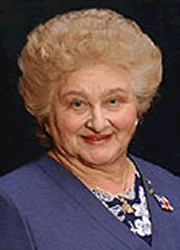Nesse Galperin
|
| http://www.bbchs.k12.il.us/Teacher_Pages/Wadley/docs/Holocaust/NesseGodintestimony.htm
Date of Birth: March 28, 1928 Nesse was born to a Jewish family in the Lithuanian city of Siauliai, not far from the Latvian border. Her parents owned a business that sold dairy products. A vibrant Jewish community thrived in Siauliai, with many synagogues, newspapers and clubs. The Jews called the city Shavli. 1933-39: I attended Hebrew school. My family was religious. I was brought up in a loving family that stressed the values of community and caring. After the Germans invaded Poland in 1939, we heard from relatives there that the Jews were being treated horribly. We couldn't believe it; how could your neighbors not stand up and help you? 1940-44: I was 12 when the Soviets annexed Lithuania in June 1940. The Germans occupied our city a year later on June 26, 1941, and began killing the Jews. Some Jewish citizens "persuaded" the Germans, with the aid of a large sum of money, that the remaining Jews were valuable for work. The Germans set up two ghettos. In 1944 as the Soviets advanced, we were deported to Stutthof, a camp on the Baltic coast. On a work detail I sorted a pile of shoes that prisoners said belonged to dead inmates. I wondered if I knew any of them. While on a death march, Nesse was liberated by the Soviet army, on March 10, 1945. She emigrated to the United States in 1950. http://www.ushmm.org/museum/publicprograms/programs/firstperson/godin.htm |
|
Nesse was born to an observant Jewish family in Siauliai, known in Yiddish as Shavl. Her parents owned a store that sold dairy products. The city was home to a vibrant Jewish community of almost 10,000 people. It had over a dozen synagogues and was renowned for its impressive cultural and social organizations. 1933–39: My family was very religious and observed all the Jewish laws. I attended Hebrew school and was raised in a loving household, where the values of community and caring always were stressed. After the Germans invaded Poland in 1939, we heard from relatives in Lodz that Jews there were being treated horribly. We could not believe it; how could your neighbors denounce you and not stand up to help you? 1940–44: On June 26, 1941, the Germans occupied our city, just four days after the invasion of the USSR. In the weeks that followed, SS killing units and Lithuanian collaborators shot about 1,000 Jews in the nearby Kuziai forest. In August, we were forced to move into a ghetto, where we lived in constant hunger and fear. There I witnessed many "selections," during which men, women, and children were taken to their deaths. My father was among them. In 1944 as the Soviet army approached, the remaining Jews were deported to the Stutthof concentration camp. There I was given the number 54015. From Stutthof, Nesse was transported to several camps, and was sent on a death march in January 1945. In the freezing cold winter weather and with little food, many of the prisoners died. On March 10, 1945, she was liberated by Soviet troops. In 1950 after spending five years in the displaced persons camp in Feldafing, Germany, Nesse immigrated to the United States. |

